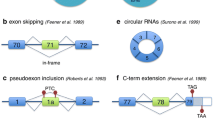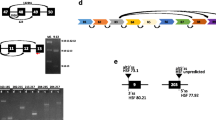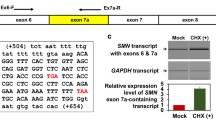Abstract
The dystrophin gene is composed of at least 86 exons and the occurrence of several alternative splicing sites, mainly occurring in its 3' region, is a well recognised phenomenon. We have found that exon 4 can also be alternatively spliced in human skeletal and cardiac muscle.
Similar content being viewed by others
References
Ahn AH, Kunkel LM (1993) The structural and functional diversity of dystrophin. Nature Genet 3:283–291
Bies RD, Phelps SF, Cortez MD, Roberts R, Caskey CT, Chamberlain JS (1992) Human and murine dystrophin mRNA transcripts are differentially expressed during skeletal muscle, heart and brain development. Nucleic Acids Res 20:1725–1731
Bloom T (1995) Brain, as well as brawn? Cuff Biol 5:338–341
Chelly J, Gilgenkrantz H, Lambert M, Hamard G, Chafey P, Recan D, Katz P, Chapelle A de la, Koenig M, Ginjaar IB, Fardeau M, Tomé F, Kahan A, Kaplan JC (1990) Effect of dystrophin gene deletions on mRNA levels and processing in Duchenne and Becker muscular dystrophies. Cell 63:1239–1248
Chomczynsky P, Sacchi N (1987) Single step method of RNA isolation by acid guanidinium thiocyanate phenol chloroform extraction. Anal Biochem 162:156–159
Dunckley MG, Wells DJ, Walsh FS, Dickson G (1993) Direct retroviral-mediated transfer of a dystrophin mini-gene into mdx mouse muscle in vivo. Hum Mol Genet 2:717–723
England SB, Nicholson LV, Johnson MA, Forrest SM, Love DR, Zubrzycka-Gaam EE, Bulman DE, Harris JB, Davies KE (1990) Very mild dystrophy associated with the deletion of 46% of dystrophin. Nature 343:180–182
Feener CA, Koenig M, Kunkel LM (1989) Alternative splicing of human dystrophin mRNA generates isoforms at the carboxy terminus. Nature 338:509–511
Gangopadhyay SB, Sherrat TG, Heckmatt JZ, Dubowitz V, Miller G, Shokeir M, Ray PN, Strong PN, Worton RG (1992) Dystrophin in frameshift deletion patients with Becker muscular dystrophy. Am J Hum Genet 51:562–570
Koenig M, Beggs AH, Moyer M, Schepf S, Heindrichs K, Bettecken T, Meng G, Muller CR, Lindlof M, Kaariainen H, Chapelle A de la, Kiuru A, Savontaus ML, Gilgenkrantz H, Recan D, Chelly J, Kaplan JC, Covone A, Archidiacono N, Romeo G, Liechti-Gallati S, Schneider V, Braga S, Moser H, Darras BT, Murphy P, Francke U, Chen JD, Morgan G, Denton M, Greenberg CR, Wrogemann K, Blonden LAJ, Paassen HMB van, Ommen GJB van, Kunkel LM (1989) The mólecular basis for Duchenne versus Becker muscular dystrophy: correlation of severity with type of deletion. Am J Hum Genet 45:498–506
Levine BA, Moir AJG, Patchell VB, Perry SV (1990) The interaction of actin with dystrophin. FEBS Lett 263:159–162
Levine BA, Moir AJG, Patchell VB, Perry SV (1991) Binding sites involved in the interaction of actin with the N-terminal region of dystrophin. FEBS Lett 298:4–18
Malhotra SB, Hart KA, Klamut HJ, Thomas NST, Bodrug SE, Burghes AHM, Bobrow M, Harper PS, Thompson Mw, Ray PN, Worton RG (1988) Frameshift deletions in patients with Duchenne and Becker muscular dystrophy. Science 242:755–759
Monaco AP, Bertelson CJ, Liechti-Gallati S, Moser H, Kunkel LM (1988) An explanation for the phenotypic differences between patients bearing partial deletions of the DMD locus. Genomics 2:90–95
Muntoni F, Gobbi P, Sewry C, Abbs S, Roberts R, Dubowitz V (1994) Deletions in the 5′ region of dystrophin and resulting phenotypes. J Med Genet 31: 843–847
Muntoni F, Melis MA, Ganau A, Dubowitz V (1995) Transcription of the dystrophin gene in normal tissues and in skeletal muscle of a family with X-linked dilated cardiomyopathy. Am J Hum Genet 56:151–157
Rafael JA, Sunada Y, Cole NM, Campbell KP, Faulkner JA, Chamberlain JS (1994) Prevention of dystrophic pathology in mdx mice by a truncated dystrophin isoform. Hum Mol Genet 3:1725–1733
Winnard AV, Klein CJ, Coovert DD, Prior T, Papp A, Snyder P, Bulman DE, Ray PN, McAndrew P, King W, Moxley RT, Mendell JR, Burghes AHM (1993) Characterization of translational frame exception patients in Duchenne/Becker muscular dystrophy. Hum Mol Genet 2:737–744
Author information
Authors and Affiliations
Rights and permissions
About this article
Cite this article
Torelli, S., Muntoni, F. Alternative splicing of dystrophin exon 4 in normal human muscle. Hum Genet 97, 521–523 (1996). https://doi.org/10.1007/BF02267079
Received:
Revised:
Issue Date:
DOI: https://doi.org/10.1007/BF02267079




